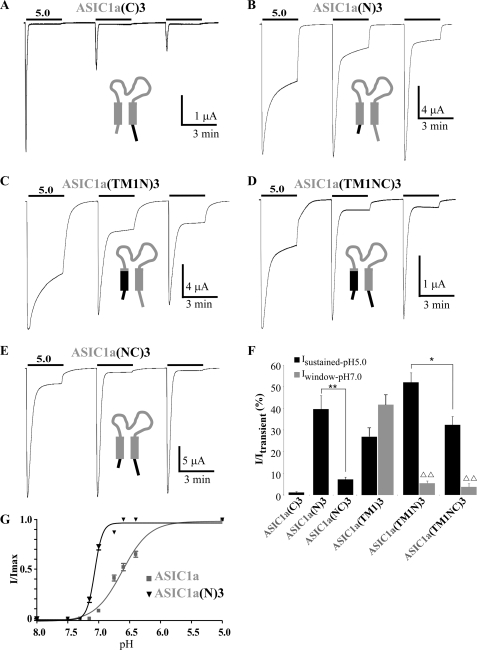FIGURE 4.
Analysis of the role of the intracellular N- and C-terminal domains in generation and modulation of the sustained current in ASIC1a/3 chimeras. A–E, representative current traces of pH 5. 0-activated currents recorded at −50 mV from Xenopus oocytes injected with ASIC1a(C)3 (A), ASIC1a(N)3 (B), ASIC1a(TM1N)3 (C), ASIC1a(TM1NC)3 (D), or ASIC1a(NC)3 (E). Three pH pulses of 3 min each are made at 3-min intervals from a holding pH of 7.4. F, average relative pH 5.0-evoked sustained current and pH 7.0-evoked window currents recorded for ASIC1a(C)3, ASIC1a(N)3, ASIC1a(NC)3, ASIC1a(TM1)3, ASIC1a(TM1N)3, and ASIC1a(TM1NC)3 (n = 11, 15, 8, 22, 23, and 14, respectively). The pH 5.0-evoked sustained currents have been measured 2 min after the peak activated by the first pH pulse as shown in A–D. ΔΔ, p < 0.01, significantly different from ASIC1a(TM1)3. G, pH-dependent activation curves of the transient current associated with ASIC1a and the ASIC1a(N)3 chimera. pH has been decreased from pH 8.0 to the indicated values (7.5/7.3/7.15/7.0/6.75/6.6/6.4/5.0) and normalized to pH 5.0. The pH0.5 values for activation of ASIC1a and ASIC1a(N)3 are 6.62 ± 0.02 and 7.06 ± 0.01, n = 8 and 7, respectively. Hill coefficients (n) calculated for ASIC1a and ASIC1a(N)3 are 1.96 and 6.96, respectively.

